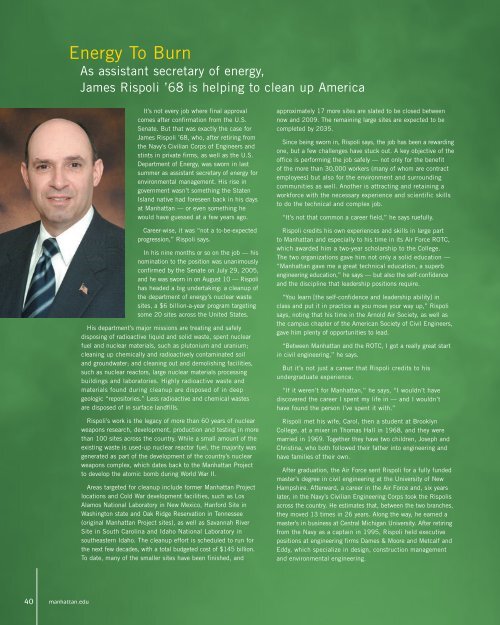on campus - Article - Manhattan College
on campus - Article - Manhattan College
on campus - Article - Manhattan College
You also want an ePaper? Increase the reach of your titles
YUMPU automatically turns print PDFs into web optimized ePapers that Google loves.
40 manhattan.edu<br />
Energy To Burn<br />
As assistant secretary of energy,<br />
James Rispoli ’68 is helping to clean up America<br />
It’s not every job where final approval<br />
comes after c<strong>on</strong>firmati<strong>on</strong> from the U.S.<br />
Senate. But that was exactly the case for<br />
James Rispoli ’68, who, after retiring from<br />
the Navy’s Civilian Corps of Engineers and<br />
stints in private firms, as well as the U.S.<br />
Department of Energy, was sworn in last<br />
summer as assistant secretary of energy for<br />
envir<strong>on</strong>mental management. His rise in<br />
government wasn’t something the Staten<br />
Island native had foreseen back in his days<br />
at <strong>Manhattan</strong> — or even something he<br />
would have guessed at a few years ago.<br />
Career-wise, it was “not a to-be-expected<br />
progressi<strong>on</strong>,” Rispoli says.<br />
In his nine m<strong>on</strong>ths or so <strong>on</strong> the job — his<br />
nominati<strong>on</strong> to the positi<strong>on</strong> was unanimously<br />
c<strong>on</strong>firmed by the Senate <strong>on</strong> July 29, 2005,<br />
and he was sworn in <strong>on</strong> August 10 — Rispoli<br />
has headed a big undertaking: a cleanup of<br />
the department of energy’s nuclear waste<br />
sites, a $6 billi<strong>on</strong>-a-year program targeting<br />
some 20 sites across the United States.<br />
His department’s major missi<strong>on</strong>s are treating and safely<br />
disposing of radioactive liquid and solid waste, spent nuclear<br />
fuel and nuclear materials, such as plut<strong>on</strong>ium and uranium;<br />
cleaning up chemically and radioactively c<strong>on</strong>taminated soil<br />
and groundwater; and cleaning out and demolishing facilities,<br />
such as nuclear reactors, large nuclear materials processing<br />
buildings and laboratories. Highly radioactive waste and<br />
materials found during cleanup are disposed of in deep<br />
geologic “repositories.” Less radioactive and chemical wastes<br />
are disposed of in surface landfills.<br />
Rispoli’s work is the legacy of more than 60 years of nuclear<br />
weap<strong>on</strong>s research, development, producti<strong>on</strong> and testing in more<br />
than 100 sites across the country. While a small amount of the<br />
existing waste is used-up nuclear reactor fuel, the majority was<br />
generated as part of the development of the country’s nuclear<br />
weap<strong>on</strong>s complex, which dates back to the <strong>Manhattan</strong> Project<br />
to develop the atomic bomb during World War II.<br />
Areas targeted for cleanup include former <strong>Manhattan</strong> Project<br />
locati<strong>on</strong>s and Cold War development facilities, such as Los<br />
Alamos Nati<strong>on</strong>al Laboratory in New Mexico, Hanford Site in<br />
Washingt<strong>on</strong> state and Oak Ridge Reservati<strong>on</strong> in Tennessee<br />
(original <strong>Manhattan</strong> Project sites), as well as Savannah River<br />
Site in South Carolina and Idaho Nati<strong>on</strong>al Laboratory in<br />
southeastern Idaho. The cleanup effort is scheduled to run for<br />
the next few decades, with a total budgeted cost of $145 billi<strong>on</strong>.<br />
To date, many of the smaller sites have been finished, and<br />
approximately 17 more sites are slated to be closed between<br />
now and 2009. The remaining large sites are expected to be<br />
completed by 2035.<br />
Since being sworn in, Rispoli says, the job has been a rewarding<br />
<strong>on</strong>e, but a few challenges have stuck out. A key objective of the<br />
office is performing the job safely — not <strong>on</strong>ly for the benefit<br />
of the more than 30,000 workers (many of whom are c<strong>on</strong>tract<br />
employees) but also for the envir<strong>on</strong>ment and surrounding<br />
communities as well. Another is attracting and retaining a<br />
workforce with the necessary experience and scientific skills<br />
to do the technical and complex job.<br />
“It’s not that comm<strong>on</strong> a career field,” he says ruefully.<br />
Rispoli credits his own experiences and skills in large part<br />
to <strong>Manhattan</strong> and especially to his time in its Air Force ROTC,<br />
which awarded him a two-year scholarship to the <strong>College</strong>.<br />
The two organizati<strong>on</strong>s gave him not <strong>on</strong>ly a solid educati<strong>on</strong> —<br />
“<strong>Manhattan</strong> gave me a great technical educati<strong>on</strong>, a superb<br />
engineering educati<strong>on</strong>,” he says — but also the self-c<strong>on</strong>fidence<br />
and the discipline that leadership positi<strong>on</strong>s require.<br />
“You learn [the self-c<strong>on</strong>fidence and leadership ability] in<br />
class and put it in practice as you move your way up,” Rispoli<br />
says, noting that his time in the Arnold Air Society, as well as<br />
the <strong>campus</strong> chapter of the American Society of Civil Engineers,<br />
gave him plenty of opportunities to lead.<br />
“Between <strong>Manhattan</strong> and the ROTC, I got a really great start<br />
in civil engineering,” he says.<br />
But it’s not just a career that Rispoli credits to his<br />
undergraduate experience.<br />
“If it weren’t for <strong>Manhattan</strong>,” he says, “I wouldn’t have<br />
discovered the career I spent my life in — and I wouldn’t<br />
have found the pers<strong>on</strong> I’ve spent it with.”<br />
Rispoli met his wife, Carol, then a student at Brooklyn<br />
<strong>College</strong>, at a mixer in Thomas Hall in 1968, and they were<br />
married in 1969. Together they have two children, Joseph and<br />
Christina, who both followed their father into engineering and<br />
have families of their own.<br />
After graduati<strong>on</strong>, the Air Force sent Rispoli for a fully funded<br />
master’s degree in civil engineering at the University of New<br />
Hampshire. Afterward, a career in the Air Force and, six years<br />
later, in the Navy’s Civilian Engineering Corps took the Rispolis<br />
across the country. He estimates that, between the two branches,<br />
they moved 13 times in 26 years. Al<strong>on</strong>g the way, he earned a<br />
master’s in business at Central Michigan University. After retiring<br />
from the Navy as a captain in 1995, Rispoli held executive<br />
positi<strong>on</strong>s at engineering firms Dames & Moore and Metcalf and<br />
Eddy, which specialize in design, c<strong>on</strong>structi<strong>on</strong> management<br />
and envir<strong>on</strong>mental engineering.


